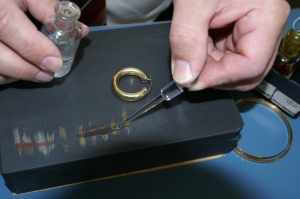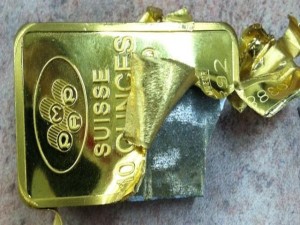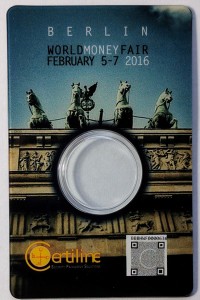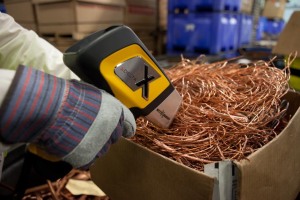All that glitters – is it Gold?
 Ever since the discovery of precious metals as a means of payment, wealth storage and vanity, there have been forgers trying to replace the valuable metals with lesser ones to make a higher profit. Early attempts may seem crude from today’s perspective but they worked for quite a long time, cheating gullible buyers out of their money. In today’s world where gold is bought and sold online and by different demographics than in the early days, forgers have stepped up their game to deceive even professional buyers. Buying from, and selling to, trustworthy partners has therefore become an increasingly important step towards protecting one’s assets. Time to explain in detail what the issues are, how reputable professionals make sure an item is authentic, and how you as an individual can protect yourself.
Ever since the discovery of precious metals as a means of payment, wealth storage and vanity, there have been forgers trying to replace the valuable metals with lesser ones to make a higher profit. Early attempts may seem crude from today’s perspective but they worked for quite a long time, cheating gullible buyers out of their money. In today’s world where gold is bought and sold online and by different demographics than in the early days, forgers have stepped up their game to deceive even professional buyers. Buying from, and selling to, trustworthy partners has therefore become an increasingly important step towards protecting one’s assets. Time to explain in detail what the issues are, how reputable professionals make sure an item is authentic, and how you as an individual can protect yourself.
Let us first separate the different groups of gold you may encounter: security-packaged investment products, unpackaged investment products and jewelry. “Investment” items, generally speaking, are bars and standard coins, which is what we will focus on today. Gold bars can range from 1 gram (g) to 400 troy ounces, the equivalent of about 12,400 grams. The most common size to-date, despite the world’s leap into the metric system, is one troy ounce, the equivalent of 31.1035 grams. To this day, the troy ounce is how gold is traded and that’s the price you see published. It also explains the existence of the 400 troy ounce bar which is the unit of trade at the world’s market places. As a private investor, you are likely to be dealing with unit sizes between one ounce and one kilogram (~ 32 ounces).
The “standard coin” market generally describes generic gold coins issued by governmental or government authorized mints such as the American “Golden Eagle”, the South African “Krugerrand”, the Canadian “Maple Leaf” or the Austrian “Vienna Philharmonics”, just to name a few. The caveat of some of these is that they are not, in fact, pure gold throwing a wrench in the most obvious testing method for gold: mass and water displacement.
Both the Golden Eagle and the Krugerrand, each in their own way, contain several percent of other metals giving them a unique appearance, and making them a little bigger. To be precise, both coins are 22 karat (91.67%) gold. The Maple Leaf and the Vienna Philharmonics are 24 karat (99.99%) gold, usually expressed as parts of thousand on the coin (meaning these coins will say 999.9 to state their purity).
As a Greek named Archimedes once discovered, it is possible to define the amount of water displaced by a specific material and, according to legend, this became the first method of verifying that what appears to be gold is in fact gold. The method is somewhat impractical and inaccurate, of course, when applied in day-to-day operation, and it was soon discovered that it could be duped by adding tungsten, a metal of almost the same molecular weight and water displacement as gold, to an item.

Other methods were called for, and this time chemistry gave the answer: Aqua Regia. “Royal Water”, a mixture of nitric and hydrochloric acid, selectively dissolves gold (and platinum) but pretty much nothing else. Invented in the 14th century, it soon became a trusted method for verifying the presence of gold. Its application requires the tester to scratch off a tiny amount of metal (hence the name “scratch test”) and then dissolve it by applying Aqua Regia with a small pipette or a brush. The method is still in use today despite its apparent downside of damaging the object to be tested, and consuming an – albeit small – amount of the metal.
 There are other pitfalls, too: the “scratch test” will only test the surface of an item, leaving the tester in the dark regarding its inside. This, in fact, is one of the most common testing issues to-date: tungsten or other metals hidden inside the item, or hollow jewelry items filled with sand or other materials.
There are other pitfalls, too: the “scratch test” will only test the surface of an item, leaving the tester in the dark regarding its inside. This, in fact, is one of the most common testing issues to-date: tungsten or other metals hidden inside the item, or hollow jewelry items filled with sand or other materials.
To counter this issue, modern testing methods for “standard” items have much evolved, starting with tamper proof packaging of many such coins or bars. Modern packaging may look like just a plastic and cardboard card but is in fact a masterpiece of combined security features that help uniquely identify the object electronically, and prevent it from being exchanged by anything else without destroying the packaging in the process.
 The picture shows a specimen card for illustration purposes. Besides the QR code, micro-engravings and multiple layers of plastic that turn opaque when tampered with are just some of the features of modern packaging. But even when packaged, professional gold buyers will analyze the precious metal object through the transparent layer by x-ray fluorescence, ultrasonic or other methods to be sure of its authenticity.
The picture shows a specimen card for illustration purposes. Besides the QR code, micro-engravings and multiple layers of plastic that turn opaque when tampered with are just some of the features of modern packaging. But even when packaged, professional gold buyers will analyze the precious metal object through the transparent layer by x-ray fluorescence, ultrasonic or other methods to be sure of its authenticity.
The object inside may itself carry a serial number, QR code, hologram or DNA marking allowing for it to be cross-referenced against a manufacturer’s database.
Coins or bars that are unpackaged will undergo even greater scrutiny. In addition to the above tests, buyers will often check for dimensional accuracy (applying Archimedes’ principles) or insist on liquefying the item by melting it, which will mix (“homogenize”) the metal, allowing for an accurate assay. This, of course, only makes sense for higher value purchases.
It is easy to see how testing for dimensional accuracy and other parameters works better on pure metals than alloys. This should, however, not be a deterrent to buy a Krugerrand for its unique appearance; as mentioned before, most professional buyers can handle it.
 Nowadays, x-ray fluorescence (XRF) analyzers are very commonplace around the world for quick and efficient precious metals analysis. Models vary from handheld (shown) to table top units depending on application and regulations on x-ray radiation. XRF is, however, very limited in the area (size and depth) it analyzes. Prudent operators will always take sets of measurements, and calculate an average.
Nowadays, x-ray fluorescence (XRF) analyzers are very commonplace around the world for quick and efficient precious metals analysis. Models vary from handheld (shown) to table top units depending on application and regulations on x-ray radiation. XRF is, however, very limited in the area (size and depth) it analyzes. Prudent operators will always take sets of measurements, and calculate an average.
 Newer methods combine weight with ultrasonic or other parameters. They are generally very accurate but work only on defined items, meaning standard coins or bars. They are favored by depositories and specialized buyers but impractical for pawn brokers who are also dealing with jewelry and other unidentifiable items.
Newer methods combine weight with ultrasonic or other parameters. They are generally very accurate but work only on defined items, meaning standard coins or bars. They are favored by depositories and specialized buyers but impractical for pawn brokers who are also dealing with jewelry and other unidentifiable items.
All of these devices are quite expensive, and they require some level of experience to provide reliable results. Unfortunately, there is no testing method of equal reliability for the occasional home user.
My advice? Visit a reputable gold buyer, preferably one who has been in business for some time, and offer what you want analyzed for sale. Most such buyers will appraise the item for you without obligation.
Which brings us to jewelry. Many of us have it, want it or not, as items of perceived value handed down from generation to generation. The important distinction here is rarity and condition. If an item isn’t of exceptional beauty and condition, or has no certifiable history giving it special value, then it is often worth only its metal value.
Evaluating these items is especially hard, and to do it reliably buyers will often have to scratch it, or cut it open to evaluate the core material. Be sure you have lost all attachment to such items prior to offering them for sale.
Also, you should know the following aspects of dealing with old jewelry:
- Stones, even diamonds, are usually scratched and not worth as much as a new one. Some buyers will send them to be refurbished or colorized but that’s an additional effort for which they will typically not issue a credit. You can always ask to keep your stones if you prefer.
- Labels can be deceiving. Many items will carry a stamp identifying the gold content on their clasp. Clasps do break, however, and because they are inexpensive, jewelers will frequently not match up a new clasp with the old one. This can go both ways, the clasp on the item may state an either higher or lower gold content. It is not a suitable indicator for an object’s gold content, and value.
- Gold buyers live to make a margin. It will take them days, sometimes weeks, to recover the money they just paid a customer. They also have to include a margin of error because, as you have learned by now, this is not an accurate process. Plus, they have to amortize all the fancy equipment and, oh yes, make a profit. Don’t expect the result to be the calculated gold contents times the current price of gold from your phone app.
- On the other hand, due diligence is always advisable when selling precious metals. Gather as much information (testimonials from friends and family, from the internet….) as possible before selling jewelry to a store or buyer. And do shop around, both sides need to make an educated decision here.
Selling jewelry is a difficult area with sellers frequently having high hopes and buyers hedging their odds against the remaining uncertainty. From a seller’s perspective, it, therefore, pays to shop around and get multiple offers for comparison.
With this in mind, you will be able to make more educated and confident decisions on what to buy, who to buy it from, and whom to sell to. Be sure that, if it glitters, it is in fact gold.
Image credits: OEGUSSA, Olympus, Sigma Metalytics, Midland Refining, public domain and own.

